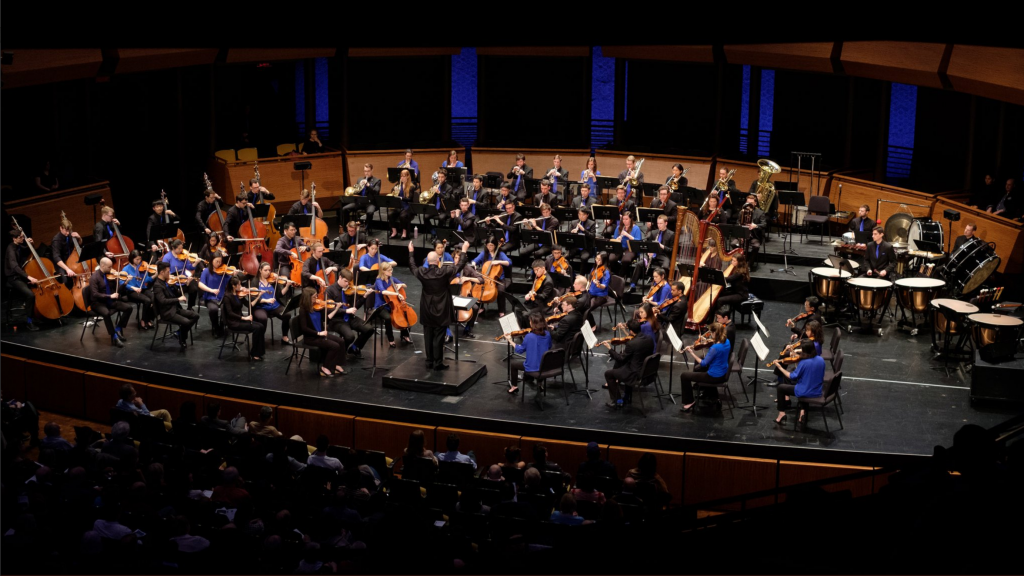
The Orchestra Now (TŌN) lined up their end of March concert with two well-curated pieces, one lesser known, Walter Braunfel’s Phantastische Erscheinungen eines Themas von Hektor Berlioz, Op. 25, and one renowned, Hector Berlioz’s Symphonie fantastique, Op. 14. Violinist Coline Berland opened the evening with a commentary on Braunfel and his piece, noting the composer’s tumultuous life, beginning as a successful musician and composer in the 1920s and 30s, but falling after the 40s when his music was labeled as degenerate. Berland added that Bruanfel’s work was “straight out of the romantic vein,” and emphasized TŌN’s effort to “revive a forgotten piece, helping us not to forget our past and history.” Each appearance of Braunfel’s Opus 25 is structured around Berlioz’s Song of the Flea from The Damnation of Faust, making the piece a highly appropriately chosen evening opener.
Phantastische Erscheinungen eines Themas von Hektor Berlioz, Op. 25 began with a light woodwind theme, echoing into the brass section and the lower strings in turn. TŌN set up a solid foundation of well-matched, synchronous sections and excellently balanced listening from the top. The Theme in Appearance one showed off the rhythmic brass section underscored by climbing strings. The driving, warning intensity of Appearance 2 nicely contrasted with Appearance 3’s light, pastoral romanticism. Conductor Leon Botstein gently led the orchestra throughout, assuredly guiding each rise and fall. The dramatic build of Appearance 7 was low-lit by arching saxophones and descending cellos, with intensity progressing as the tempo picked up. The latter appearances built gradually, showing the dexterity of the string sections as they oscillated between frantic scaling and pizzicato tempering. Botstein closely facilitated the building suspense of the funeral march in Appearance 11, seamlessly highlighting the lyrical harmonies of Appearance 12. The Finale, intended by the composer to be “Lively”, victoriously resolved the banter between the strings and brass, repeating the earlier themes of the work in rising resolve.
Tuba player Dan Honaker offered playful rhetoric to prelude Berlioz’s Symphonie fantastique post intermission, detailing that the work predated the tuba by only a decade, eventually making it one of the earliest pieces available to play on tuba. “It’s fun for us to play,” recounted Honaker. As additioned by TŌN’s Kelly Mozeik in the program notes, Berlioz was among the earliest composers to use orchestral structure to tell an entire story. Based on the composer’s own infatuation with actress Harriet Smithson, Opus 14 details the tale of a desperate artist who falls for his soul mate, eventually poisoning himself in anguish. His subsequent opium-inspired nightmare bears him witness to his own execution in March to the Scaffold, then a Dream of a Witches’ Sabbath, in which he watches his love participate in a satanic dance.
The first movement, Reveries, Passions, moved with warm, engulfing swells, featuring the gentle, lilting flutes and percussive strings. Conductor Botstein appeared to actively feel the story as he progressively led the musicians. Movement 2, A Ball, perhaps the most recognizable and often featured movement of this work, illustrated the cheery dance sequence with lithe, sweet violins and active woodwinds, spelling out a picture of promenade partnership in a flirty exchange between the strings, winds, and brass. A Scene in the Fields followed with the notable oboe solo, echoed by slow-building woodwinds and symbolic sectioning. Conductor Botstein offered close, indicative suggestion as the sustained brass undertones built beneath the violin and oboe call and response. Movement 4, A March to the Scaffold, brought the timpani to life with driving, percussive foreboding dominating each solitary section. The regal drama of the movement brought to life TŌN’s excellent attention to dynamic levels with markedly frantic crescendos and decrescendos. The close specification added to the effective story-telling of the evening. The final movement, Dream of a Witches’ Sabbath, featured free-hanging, solo-esque offerings with intense orchestral response. TŌN clearly demonstrated their enthusiastic commitment to both theme and narrative with an animated ascent into the nightmarish, eerie finale.
 Sunday, July 13, 2025
Sunday, July 13, 2025